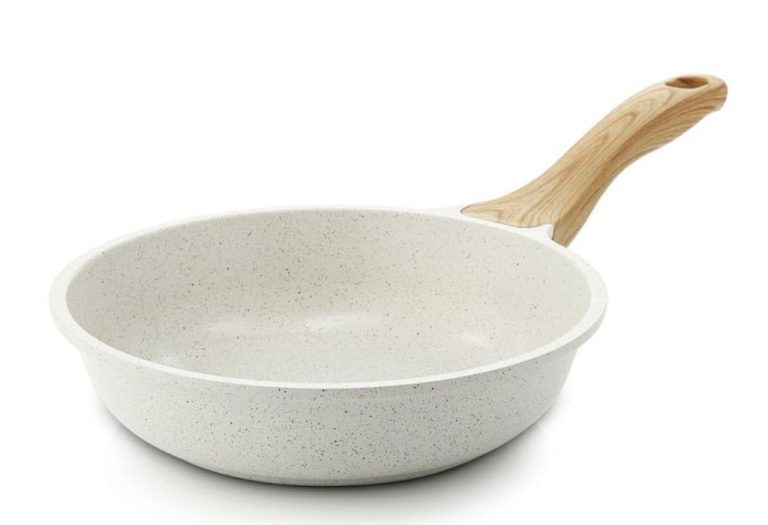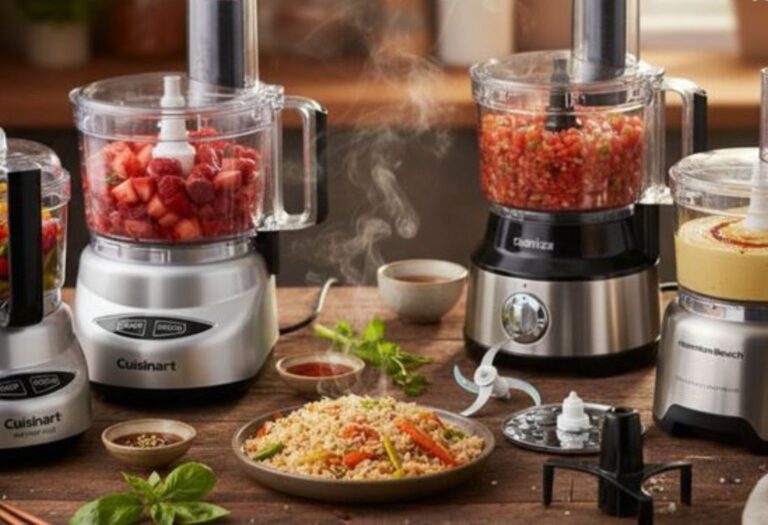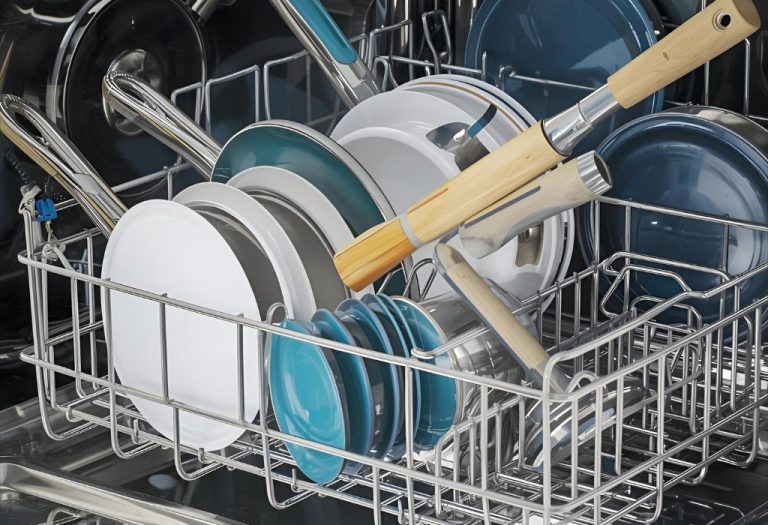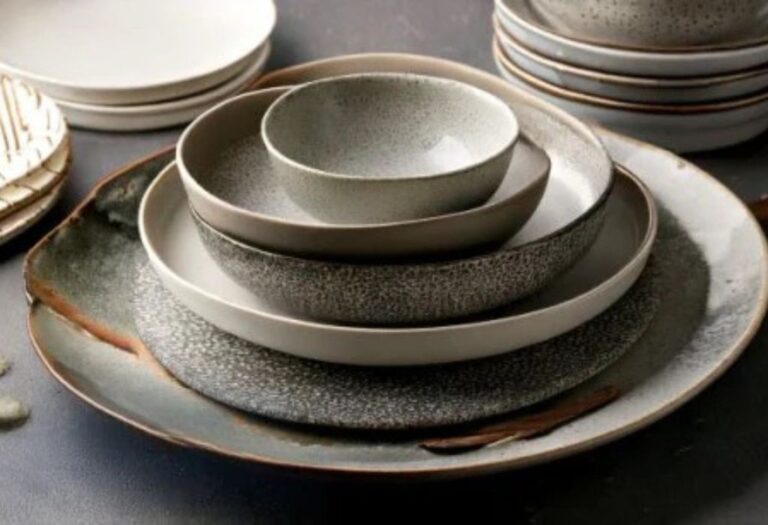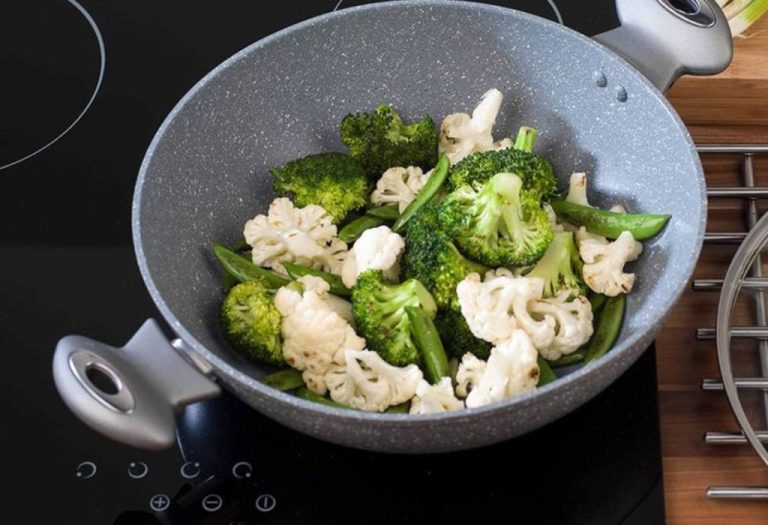The scrape of a metal spatula against a shiny ceramic pan is a sound that makes many cooks pause.
The question immediately follows: can you use metal utensils on ceramic cookware without ruining its smooth surface.
The problem is not just about scratches on a pan.
It is about how those scratches affect performance, durability, and even long-term safety in the kitchen.
Curiosity grows as manufacturers often promise “scratch-resistant” ceramic coatings.
Yet countless home kitchens see chips, scrapes, and fading nonstick layers far earlier than expected.
Research shows that more than 70 percent of consumers replace nonstick cookware within five years, often due to utensil damage and coating wear (Consumer Reports).
Another study found that surface abrasion is a leading cause of nonstick failure, reducing performance and shortening cookware lifespan (Medical News Today).
The benefit of understanding this issue is clear.
Knowing whether metal utensils are safe for ceramic cookware helps protect investments, extend the lifespan of pans, and maintain safe cooking surfaces.
What Is Ceramic Cookware and Its Coating Structure
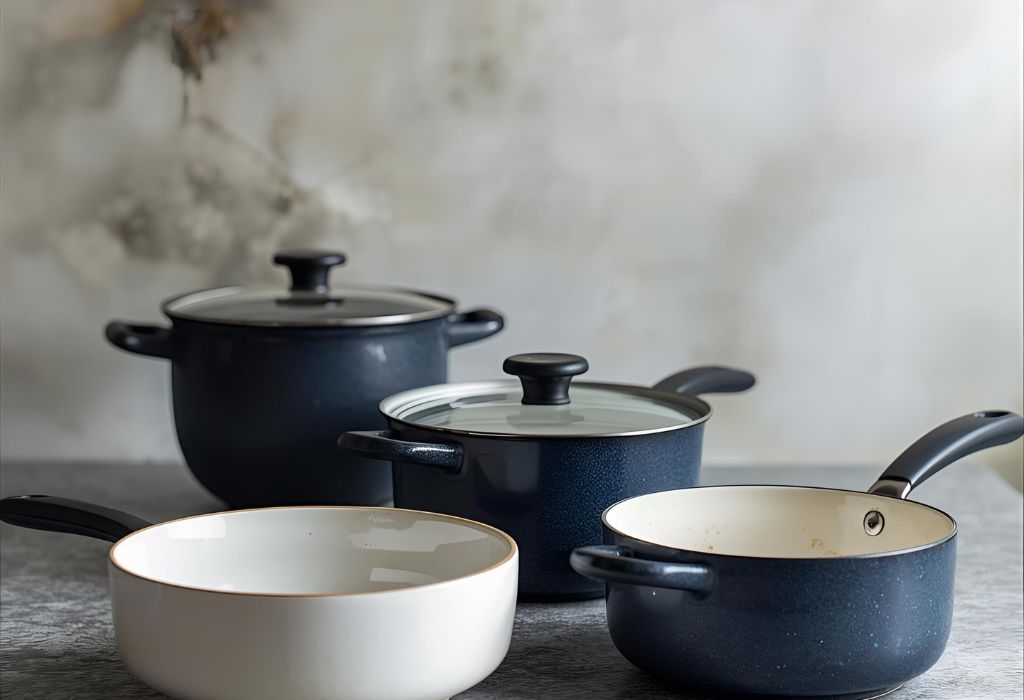
Ceramic cookware can mean two very different products.
Some pieces are made entirely of clay or porcelain enamel, while others are metal pans coated with a thin ceramic-based sol-gel layer.
Pure ceramic cookware is kiln-fired and valued for its durability and heat retention.
Ceramic-coated cookware uses aluminum or stainless steel as a base, topped with a smooth, silica-based layer that provides nonstick qualities.
These coatings are often marketed as PTFE- and PFOA-free, making them attractive to health-conscious buyers.
However, their thickness is limited, which makes them vulnerable to scratches and chips.
When the surface is damaged, the nonstick release weakens and food begins to stick.
In severe cases, the base metal underneath may be exposed, reducing both performance and safety.
Understanding the structure of ceramic cookware is essential before asking if metal utensils are safe to use.
The answer depends heavily on whether the pan is pure ceramic or simply coated with a fragile nonstick layer.
Q: What is the difference between pure ceramic and ceramic-coated cookware?
A: Pure ceramic is made from hardened clay, while ceramic-coated cookware is metal with a ceramic nonstick surface.
Q: Are ceramic coatings free from PTFE and PFOA?
A: Yes, most ceramic coatings are marketed as free from these chemicals.
Q: What happens when the ceramic coating gets scratched?
A: The coating loses its nonstick ability and may expose the underlying metal.
Q: Is porcelain enamel the same as ceramic cookware?
A: Porcelain enamel is a type of ceramic glass fused to metal, offering longer durability than thin coatings.
Q: Why is coating thickness important?
A: Thicker coatings resist scratching better, while thinner ones wear down more quickly.
Can You Use Metal Utensils on Ceramic Cookware? What Experts Say
The smooth, glossy surface of ceramic cookware looks strong, but appearances can be misleading.
Most manufacturers caution against using metal utensils because scratches and chips form easily under sharp edges.
Some brands advertise their pans as “metal utensil safe,” but this usually comes with fine print.
The allowance often applies only to smooth-edged tools and excludes knives, forks, or sharp spatulas.
Cooking experts generally agree that metal use shortens the nonstick lifespan of ceramic coatings.
Even light scratches can reduce food release and make cleaning more difficult over time.
Manufacturer guidelines are the most reliable resource.
If instructions warn against metal utensils, ignoring them can void warranties and reduce the pan’s lifespan.
Ultimately, the debate is less about possibility and more about risk.
Yes, metal utensils can be used, but the long-term cost is often damage that could have been avoided.
Q: Is it ever safe to use metal utensils on ceramic cookware?
A: Occasionally, but it always increases the risk of scratches and coating damage.
Q: Which types of metal utensils are most damaging?
A: Forks, knives, and sharp spatulas cause the most scratches.
Q: Do any ceramic cookware brands allow metal utensils?
A: Some claim to, but always check the care instructions for restrictions.
Q: Are light surface scratches a serious problem?
A: Minor marks may be cosmetic, but deeper scratches affect performance and safety.
Q: Can exposed base metal change how food cooks?
A: Yes, exposed areas heat differently and may lead to uneven cooking or sticking.
Risks of Using Metal Utensils on Ceramic Cookware
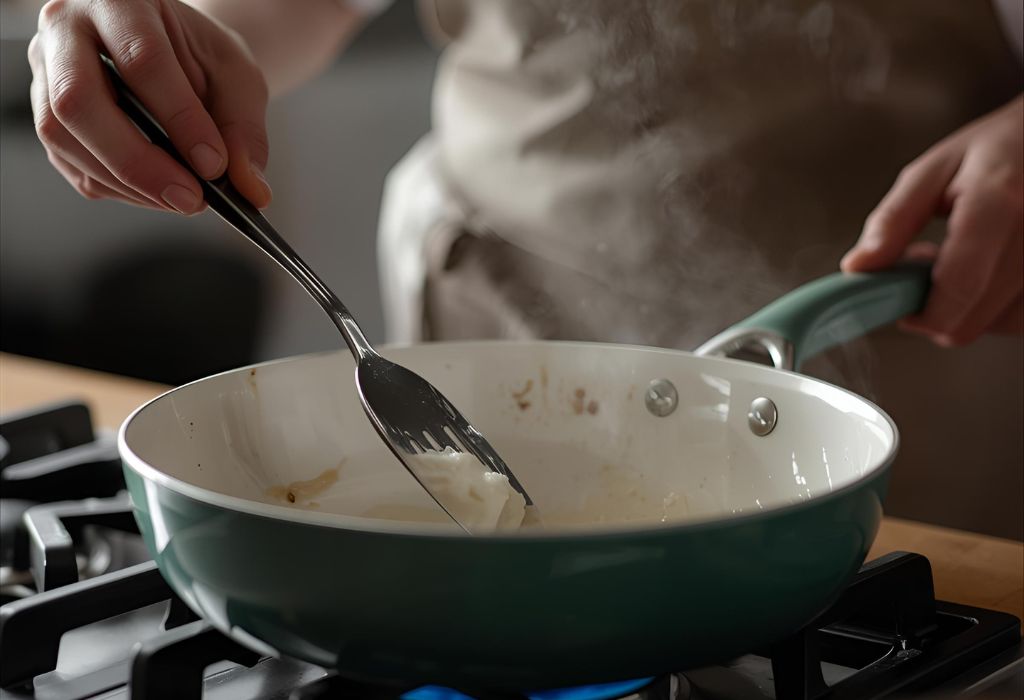
Metal utensils may seem harmless, but they create micro-scratches that weaken ceramic coatings over time.
These scratches accumulate, causing food to stick and coatings to lose their smooth release.
Chipping is another common issue when sharp edges dig into the surface.
Once chips form, the coating can flake and expose the base metal underneath.
Health concerns also emerge when coatings are damaged.
While quality ceramic is generally inert, cheap or poorly made products may leach trace metals when the surface breaks down.
Even if safety risks are minimal, performance suffers significantly.
A scratched or chipped ceramic pan quickly shifts from effortless nonstick cooking to constant sticking and frustration.
Replacing pans earlier than expected adds financial and environmental costs.
Scratches from metal utensils are one of the fastest ways to shorten the lifespan of ceramic cookware.
Q: Does scratching ceramic cookware release harmful toxins?
A: Quality ceramic is inert, but damage in low-quality coatings may raise concerns.
Q: Can chips affect cooking performance?
A: Yes, chipping leads to sticking and uneven heating.
Q: Does exposing the base metal matter?
A: It reduces performance and may compromise food safety depending on the metal.
Q: Do studies confirm that metal utensils wear coatings faster?
A: Yes, abrasion testing shows coatings fail sooner under repeated metal contact.
Q: Are the risks mostly cosmetic or functional?
A: Both, since visible damage reduces appeal and functional quality at the same time.
How to Use Metal Utensils Safely (If Necessary)
The safest option is to avoid metal utensils entirely with ceramic cookware.
Still, if metal must be used, there are ways to reduce the risk of damage.
Smooth-edged tools such as rounded spoons are less likely to scratch than forks or sharp spatulas.
Avoid cutting food directly in the pan, since knives create deep grooves that coatings cannot withstand.
Lower heat also makes a difference.
Ceramic coatings soften slightly at high temperatures, which increases vulnerability to scratching.
It is also safer to wait until cookware cools before using metal.
Hot surfaces are more prone to chips, while cooler ceramic handles pressure better.
Occasional, gentle use of smooth metal may not ruin a high-quality pan.
However, repeated scraping will still shorten the nonstick lifespan significantly.
Q: What types of metal utensils are least harmful?
A: Smooth spoons or ladles without sharp edges.
Q: Should knives or forks ever be used in ceramic pans?
A: No, these tools cause deep scratches quickly.
Q: Does reducing heat lower the risk of scratches?
A: Yes, cooler coatings are more resistant to utensil damage.
Q: Is it safer to stir with metal when food is already inside?
A: Somewhat, as food acts as a buffer, but scratching can still occur.
Q: Can occasional use of metal ruin ceramic cookware immediately?
A: Not usually, but repeated use will lead to visible wear and shorter lifespan.
Alternative Utensils for Ceramic Cookware
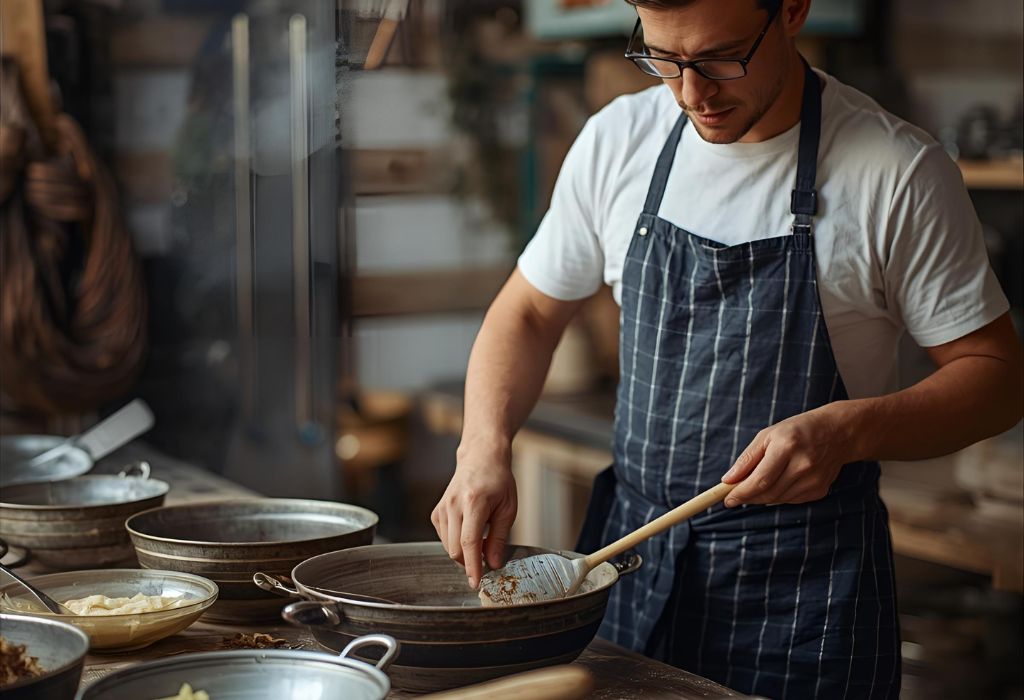
The best way to keep ceramic cookware intact is to swap metal utensils for softer alternatives.
Materials like silicone, wood, bamboo, and nylon protect the coating and extend the pan’s lifespan.
Silicone utensils are heat resistant and flexible.
They do not scratch surfaces and are easy to clean after cooking.
Wooden and bamboo utensils are sturdy and classic.
They work well for stirring and flipping but should be kept dry to avoid warping or splintering.
Nylon utensils are lightweight and affordable.
However, they can melt if exposed to temperatures above 400°F, making them less durable than silicone.
Choosing the right utensil material depends on cooking style and care preferences.
All of these options are safer than metal when it comes to ceramic cookware.
Q: Is silicone safer than wood for ceramic pans?
A: Yes, silicone resists heat better, though both are non-scratching options.
Q: Can nylon utensils damage ceramic cookware?
A: No, but they may melt at high heat, which reduces their usefulness.
Q: Are bamboo utensils durable in daily cooking?
A: Yes, but they need proper drying to avoid cracking or mold.
Q: Is plastic safe to use with ceramic cookware?
A: Softer plastics may degrade; high-quality, food-safe options are better.
Q: Which alternative is easiest to clean?
A: Silicone, as it resists staining and does not absorb food odors.
Signs That Metal Utensil Damage Has Occurred and When to Replace
Ceramic cookware often shows visible signs when damage from metal utensils has taken place.
The most common are scratches across the surface, which reduce the smooth nonstick release.
Chips and cracks are more serious indicators.
They expose the base metal underneath, which not only looks unappealing but also shortens the pan’s safe lifespan.
Food sticking is another red flag.
When ceramic pans begin to lose their slick coating, even simple dishes like eggs become difficult to cook.
Discoloration may also appear in heavily used pans.
Although stains alone are not unsafe, they often signal coating fatigue or wear.
Replacement is the best option once deep scratches, chips, or persistent sticking occur.
A damaged pan cannot be restored to its original performance.
Q: When do scratches become a real problem?
A: When they are deep enough to affect cooking or expose the underlying metal.
Q: Is chipping more serious than scratching?
A: Yes, chipping weakens the coating faster and may pose safety concerns.
Q: Can cleaning restore damaged ceramic cookware?
A: No, scratches and chips cannot be repaired once they form.
Q: Does uneven cooking indicate utensil damage?
A: Yes, worn coatings often cause food to burn or stick in certain spots.
Q: How often should ceramic cookware be replaced?
A: Typically every 1–3 years for ceramic-coated pans, or sooner if severe damage is visible.
Best Practices to Maintain Ceramic Cookware
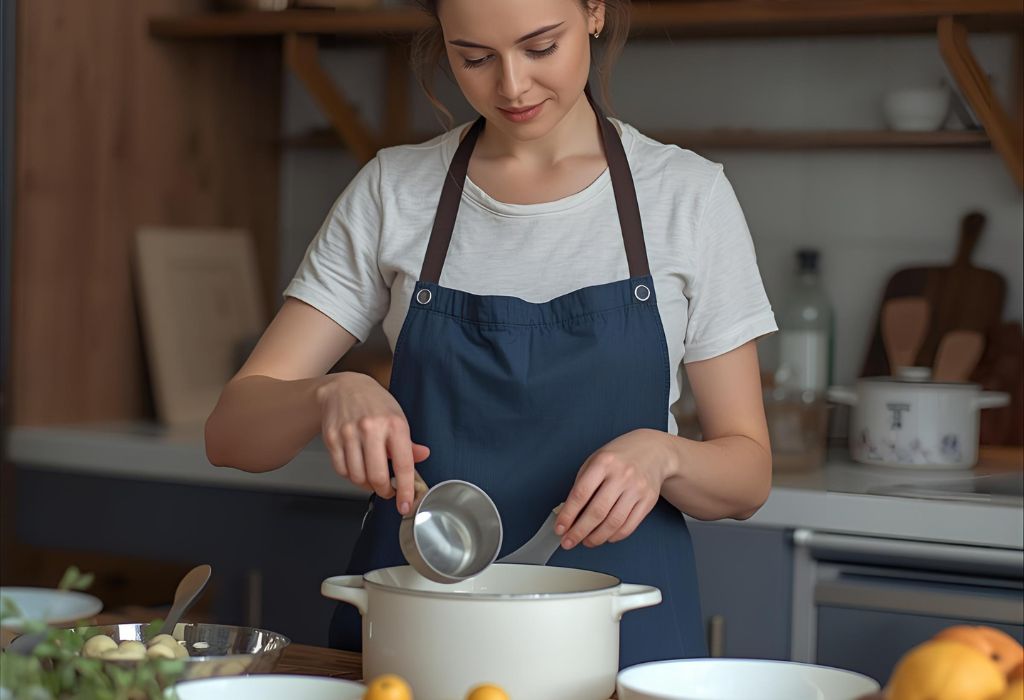
Proper maintenance is the key to making ceramic cookware last longer.
Following simple routines can prevent scratches, chips, and premature wear.
Always use non-abrasive utensils like silicone, wood, or bamboo.
These materials protect the coating and reduce the risk of surface damage.
Cooking on low to medium heat is another essential habit.
High heat weakens the ceramic layer, making it more prone to scratches and cracks.
Handwashing with mild soap and soft sponges is strongly recommended.
Dishwashers and harsh cleaners erode coatings and shorten the cookware’s lifespan.
Safe storage also matters.
Stacking pans without protection causes abrasion, so use felt pads or hang pans individually.
Q: What cleaning tools are safe for ceramic cookware?
A: Soft sponges or cloths, never steel wool or abrasive scrubbers.
Q: Can ceramic cookware go in the dishwasher?
A: Some brands allow it, but handwashing is always safer for longevity.
Q: How should ceramic pans be stored to prevent damage?
A: Use pan protectors or hang them separately.
Q: Is it important to follow the manufacturer’s care instructions?
A: Yes, each brand sets specific guidelines for safe use and cleaning.
Q: How often should cookware be inspected for damage?
A: Regularly, especially if the pan is used daily or exposed to heavy cooking tasks.
When Using Metal Utensils Might Be Acceptable and Brand Differences
Not all ceramic cookware reacts the same way to metal utensils.
Some brands design thicker, harder coatings that resist scratches better than budget alternatives.
A few companies even advertise their pans as “metal utensil safe.”
This usually means occasional use of smooth-edged tools is acceptable, but sharp forks and knives are still discouraged.
Premium cookware with high-quality sol-gel coatings may handle limited contact with metal.
However, frequent use still leads to gradual surface wear and reduced nonstick performance.
Manufacturer warranties often exclude utensil-related damage.
Ignoring brand-specific guidelines can void coverage and shorten cookware lifespan.
The safest approach is to check care instructions before relying on metal utensils.
Brand differences mean what works for one pan may ruin another.
Q: Which brands allow metal utensils on ceramic cookware?
A: Some advertise tolerance, but it depends on the coating’s thickness and quality.
Q: Does a thicker ceramic coating handle metal better?
A: Yes, thicker coatings resist scratching longer, though not indefinitely.
Q: Is occasional use of smooth-edged metal acceptable?
A: Yes, but regular use will still shorten the pan’s nonstick lifespan.
Q: Do warranties cover damage from metal utensils?
A: Usually not, since this is often considered misuse.
Q: Does higher price guarantee metal utensil safety?
A: No, quality matters more than cost, so always verify manufacturer claims.
Alternatives: Utensils and Cookware Options If Metal Must Be Used

For cooks who prefer metal utensils, switching cookware types may be a better solution.
Cast iron, carbon steel, and stainless steel tolerate scraping, stirring, and cutting without surface damage.
Ceramic-coated pans, on the other hand, require softer tools.
Brands often recommend silicone, bamboo, or wooden utensils to prevent scratches and chips.
Hybrid utensils combine metal handles with silicone tips.
These provide the strength of metal while keeping surfaces safe from abrasion.
Some cookware sets include utensil kits designed to match the pans.
Using the provided tools ensures the cookware lasts as long as possible.
When cookware choice matches utensil preference, durability and cooking performance both improve.
This prevents the frustration of constantly replacing damaged pans.
Q: Which cookware types are safe for full metal utensil use?
A: Cast iron, stainless steel, and carbon steel are best.
Q: Can ceramic cookware ever be fully metal-safe?
A: Not completely, though premium coatings may resist scratches better.
Q: Are silicone-tipped metal utensils safer for ceramic pans?
A: Yes, they protect the coating while offering durability.
Q: Do ceramic cookware sets include matching utensils?
A: Many do, often providing silicone or wood tools.
Q: Is it better to mix cookware types for different tasks?
A: Yes, use ceramic for low-stick cooking and metal-safe pans for high-heat or heavy utensil work.
Conclusion
The question can you use metal utensils on ceramic cookware does not have a simple yes or no answer.
While occasional use of smooth-edged tools may not cause immediate harm, repeated scraping quickly shortens the lifespan of ceramic coatings.
Scratches, chips, and exposed base metal reduce nonstick performance and make cooking frustrating.
They also lead to earlier replacements, adding both cost and environmental waste.
The safest approach is to avoid metal utensils and rely on silicone, wood, or bamboo tools.
These materials protect the coating, preserve nonstick quality, and extend the life of cookware.
For those who prefer using metal, alternatives such as stainless steel, cast iron, or carbon steel are better suited.
These options handle metal utensils without losing durability or safety.
Ultimately, the choice comes down to balancing convenience with care.
By respecting manufacturer guidelines and selecting the right utensils, ceramic cookware can deliver safer, longer-lasting performance in any kitchen.
I’m Emma J. Caldwell, the founder, lead writer, and home-cooking enthusiast behind KitchenGuideCo.com. With a background in culinary arts and over a decade of cooking experience in both professional and personal kitchens, I created this platform to demystify recipes, offer smart kitchen gadget reviews, and guide readers through meal prep with confidence and clarity.


